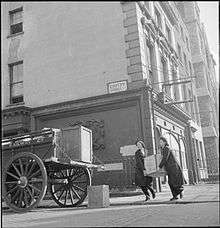Tea chest


A tea chest is a type of wooden case originally produced and used to ship tea to the United Kingdom, Australia and New Zealand. The conventional tea chest is a case with riveted metal edges, of approximate size 500x500x750 millimetres (20x20x30 inches).
The term is now used more widely to indicate similarly-sized cases, including cardboard cases, produced for various home and commercial uses.
History
A tea chest holds 42 to 58 kilogrammes of tea[1] the size depends on the origin and client. Sizes vary from 400×400×620 to 500×500×750 mm.
The traditional construction was of wood held at the edges with metal edges, riveted to the sheets. Internally tea chests were often lined with metal foil, and strengthened with inch-by-inch boards at the edges.
The foil was stated as lead in this Bushell's 1925 advertisement[2] but later changed to aluminium foil.
Tea chests were one-trip affairs, so they were generally sold for non-food use.
During the 1950s throughout the UK, tea chests began to be used as basic basses in skiffle groups, such as the Quarrymen.
See also
References
- ↑ The Economist, (UK Magazine) (1994). Desk Companion. London: Penguin. p. 31. ISBN 0 241 00265 6.
- ↑ "Bushells Blue Label Tea: Bushells Tea Factory". National Film and Sound Archive. 1925. Retrieved 17 February 2014.